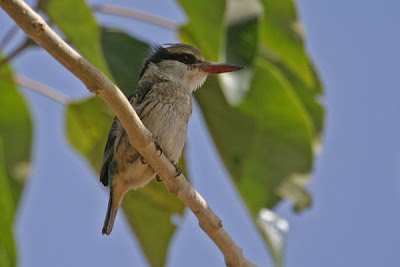Day 7: The start of our upriver adventure was today's long and dusty drive to Tendaba Camp. Much needed improvements to long sections of the road are currently in progress but unless you've been before and remember how bad it used to be, you might not be impressed. We arrived at our destination with red dust covering everything and everybody! A stop on the way at some woodland near Pirang produced Green Hylia, Green Crombec and Yellowbill, none of them easy to find and all of them difficult to see.
 The Road to Tendaba
The Road to Tendaba Welcome to Tendaba
Welcome to Tendaba African Darter
African Darter African Finfoot
African FinfootDay 9: Another travelling day as we headed further upriver for a two-night stay at Bird Safari Camp, located on MacCarthy Island, more usually referred to as Janjangbureh. Most of the journey was on a very good road along the north bank of the river but first we had to put up with a long stretch of pot-holes on the south side before taking the ferry that is part of the Trans-Gambia Highway linking the north of Senegal with the south. There was a long queue of mainly Senegalese trucks waiting to cross but in no time at all we somehow found ourselves well towards the front of this queue and sure enough we made it on to the next ferry crossing. It seems that it's just a matter of talking to the right person and offering the right incentive! Later, more than 100 bird species were recorded as we made a succession of stops at various wetlands on the north bank. They included the must-see species of this and every other tour in The Gambia, the striking and unmistakeable Egyptian Plover. What a relief!

Egyptian Plover

Ferry Crossing
Day 10: Most of the morning was spent at a nesting colony of spectacular Red-throated Bee-eaters at Bansang, the afternoon at the ricefields at Jakhaly. Both sites are on the south bank of the river so there were more interesting ferry crossings. It was one of the hottest days of the tour, the temperature reaching about 35ºC. Again more than 100 bird species were seen, a total that included Lappet-faced among five species of vultures. Among the most memorable birds was the Exclamatory Paradise Whydah with a tail to match the length of its name.
On the way back to Janjangbureh we called at Brikamaba where, thankfully, two Verreaux's Eagle Owls were roosting exactly where they always roost. If all birds were as reliable as these, this guiding job would be a doddle!

Exclamatory Paradise Whydah

Red-throated Bee-eater
Day 11: After two nights at Bird Safari Camp we started the long journey back to the coast, returning first of all to Tendaba. Once again, in spite of the long distance covered, we saw lots of good birds including Spotted Thick-knees, found when we were actually searching for bustards. It was dark long before we reached our destination but that didn't mean we couldn't stop to look for owls and nightjars and there was also a huge Puff Adder on the road that caused us to pause for a while.

Spotted Thick-knee
Day 12: Another hot, sunny morning was spent in nearby Kiang West National Park and Batelling Woods. During the afternoon we repeated the boat trip with Wandi hoping to see one or two species additional to the ones seen last time. Woolly-necked Storks fell into this category but more remarkable and unexpected in the mangroves were two Abyssinian Ground Hornbills.
After dinner our trip out to look for owls and nightjars proved something of a disappointment. We did get excellent views of African Scops Owl but where were all the nightjars? Reluctant to give up, we stayed out until after 11.00pm by which time not many in the bus were still awake!

Woolly-necked Stork

Abyssinian Ground Hornbill
Day 13: We made the long trip back to the coast today with several birding stops on the way. We began near Wurokang where we had an excellent hour or so in woodland that was full of birds including White-shouldered Black Tit, Brown-rumped Bunting and a scarce Yellow-bellied Hyliota. Later, at Faraba Banta we met up with local guide, Abdoulaye, who had a roosting Greyish Eagle Owl to show us, a bird that we would never have found without his help. Bonuses here were a Bateleur and a pale-phase Booted Eagle.
Our last night in The Gambia was back at the Senegambia Beach Hotel where our first hot shower for a week was much appreciated by all!
Day 14: There was time for a return to Kotu this morning, ending the tour where it began, at the sewage ponds. A Little Grebe became the last new species of the tour and then it was lunch at the Paradise Beach Bar before afternoon flights returned us to the cold of the UK.
















